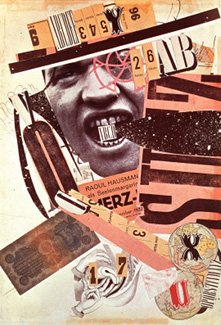






Dada artists felt the war called into question every aspect of a society capable of starting and then prolonging it – including its art. Their aim was to destroy traditional values in art and to create a new art to replace the old. As the artist Hans Arp later wrote:
Revolted by the butchery of the 1914 World War, we in Zurich devoted ourselves to the arts. While the guns rumbled in the distance, we sang, painted, made collages and wrote poems with all our might.
In addition to being anti-war, dada was also anti-bourgeois and had political affinities with the radical left.
The founder of dada was a writer, Hugo Ball. In 1916 he started a satirical night-club in Zurich, the Cabaret Voltaire, and a magazine which, wrote Ball, ‘will bear the name ”Dada”. Dada, Dada, Dada, Dada.’ This was the first of many dada publications. Dada became an international movement and eventually formed the basis of surrealism in Paris after the war.
Leading artists associated with it include Arp, Marcel Duchamp, Francis Picabia and Kurt Schwitters. Duchamp’s questioning of the fundamentals of Western art had a profound subsequent influence.